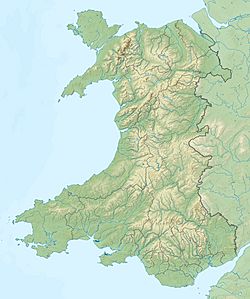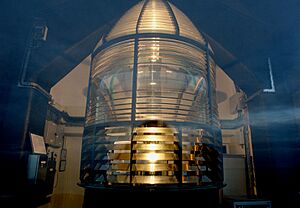Point Lynas Lighthouse facts for kids
 |
|
| The Lighthouse at Point Lynas | |
|
|
|
| Location | Llaneilian Anglesey Wales |
|---|---|
| Coordinates | 53°24′59″N 4°17′21″W / 53.416287°N 4.289198°W |
| Year first constructed | 1766 (first) |
| Year first lit | 1835 (current) |
| Automated | 1989 |
| Tower shape | lantern at ground level attached to a square castellated tower |
| Markings / pattern | white tower and lantern |
| Height | 11 metres (36 ft) |
| Focal height | 39 metres (128 ft) |
| Current lens | 2nd Order catadioptric fixed |
| Intensity | 89,900 candela |
| Range | 18 nautical miles (33 km; 21 mi) |
| Characteristic | Oc W 10s. |
| Fog signal | blast every 45s. (ceased operation in 2012) |
| Admiralty number | A5160 |
| NGA number | 5464 |
| ARLHS number | Wal-019 |
The Point Lynas Lighthouse (also known as Welsh: Goleudy Trwyn y Balog in Welsh) stands on a headland in Llaneilian, a community on the north-east tip of Anglesey in North Wales.
This important lighthouse helped guide ships safely into and out of Liverpool's busy port. A special station for pilots (people who guide ships) was set up here in 1766. A lighthouse was added in 1779. The building you see today was finished in 1835. It was built on a high hill, so it didn't need a tall tower like many other lighthouses.
The Mersey Docks and Harbour Board built and looked after the lighthouse for many years. In 1973, Trinity House, the official lighthouse authority in England and Wales, took over its care. By 2001, the lighthouse lights became fully automated. This meant that no staff needed to live there anymore. The old lighthouse keepers' homes were sold and are now used as private houses and holiday rentals.
Contents
The Lighthouse's Design and History
This lighthouse looks very unique! It was designed by Jesse Hartley, a famous engineer who worked for the Mersey Docks and Harbour Board from 1824 to 1860. Some parts were added later by G. Lyster.
The building looks a bit like a castle, with a two-story house. On top of the house is a square tower, about 11 metres (36 ft) (36 feet) tall. What's unusual is that the main light (the lantern) is located at the bottom of the building, not at the very top of the tower.
The current lantern was put in around 1874. It is about 4.6 metres (15 ft) (15 feet) wide. It has a strong cast-iron base and tall glass panels. The top of the lantern has a simple cone-shaped roof with a decorative ball on top. Above the lantern, the square tower has a special oriel window that sticks out. This was used as a look-out point for the pilots.
Why the Lighthouse Moved
The very first light at Point Lynas was lit in 1779. It was about 300 metres (980 ft) (984 feet) south of where the lighthouse stands today. This first location helped pilots from Liverpool find shelter in a nearby cove called Porthyrysgaw.
However, the lighthouse was moved to its current spot in 1835. This new location was better because it was higher up, about 39 metres (128 ft) (128 feet) above the sea. Being so high meant that a tall tower wasn't needed to make the light visible from far away.
How the Light Works
The way the lantern is at ground level, with the look-out room above it, is quite unusual. The Great Orme Lighthouse, also built by the Mersey Docks and Harbour Board, has a similar design.
In 1879, a telegraph station was added to Point Lynas. This allowed messages to be sent quickly. Two new cottages were built for the extra staff needed to run the telegraph station.
In 1878, a special lens system called a Chance Brothers occulting optic was installed. This lens is 1.4 metres (4 ft 7 in) (4.6 feet) wide. It makes the light visible across 206 degrees of the sea. The lens has different sections that work together to focus the light.
The lamp inside is very powerful, using 1000 watts of electricity. It shines with an intensity of 112,000 candela (a unit of light brightness). The light is white and appears to "blink" or occult every 10 seconds. This means the light is on for a period, then briefly off, then on again. It can be seen from about 20 nautical miles (37 km; 23 mi) (37 km or 23 miles) away!
Modern Changes: Electrification and Automation
Big changes came to Point Lynas Lighthouse over the years:
- 1952: The lighthouse was connected to electricity. This meant the old mechanical parts that made the light blink were removed.
- 1948: An automatic fog-gun was installed. This device used acetylene gas to make loud blasts during foggy weather.
- 1973: When Trinity House took over, they removed the fog-gun. They replaced it with electrical emitters that made fog signals.
- 1989: The lighthouse became fully automated. This means computers now control the light. It is managed remotely from Holyhead.
Because the lighthouse no longer needed people to live there, the lighthouse keepers' cottages were returned to the Mersey Docks and Harbour Company. They then sold the cottages. Today, some are private homes, and others are rented out for holidays.
Why Point Lynas Lighthouse is Important
The Point Lynas Lighthouse is historically important for a few reasons:
- It shows the work of Jesse Hartley. He was the engineer who created the world's first large floating-dock system in Liverpool.
- It played a key role in guiding ships to and from one of the busiest ports in the world.
- Its unique design, with the lantern at ground level, makes it stand out from many other lighthouses.
Images for kids





